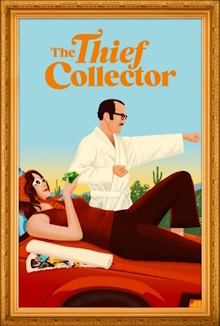A valuable painting is stolen from a museum in 1985. Thirty years later it turns up in the estate of a deceased couple who are seemingly ordinary retired teachers. I don’t much care for the painting itself but the story that this documentary pieces together about the secret life of this couple is extraordinary. To supplement the interviews with the people who knew the couple and those familiar with the theft, actors reenact key scenes in a bold style that looks almost like something by Wes Anderson. I had doubts at first that it would hold my interest, but by the end I agree with the maker of this piece Allison Otto that someone should make a full feature film about this.
A passage from a short story describes a couple who steals artwork from museums for the thrill of it, claiming that its a victimless crime. It comes from a self-published book by Jerry Alter, a retired teacher and musician who lives in New Mexico. It seems harmless and unremarkable, except that after the Alters passed away, the contents of their house were sold to the owner of an antique shop. Among the large collection of souvenirs and artwork from the couple’s extensive travels was found an oil painting later identified to be Woman-Ochre by Willem de Kooning. It was last seen hanging in the University of Arizona Museum of Art in 1985 and stolen by a couple according to eyewitnesses at the time. This documentary assembles the wealth of circumstantial evidence that ties the Alters to the crime and interviews their friends and relatives to find out what kind of people they were. Everyone professes shock that they might have been secretly living a double life as they seemed to be teachers living a modest life and well loved by everyone. Some did wonder how they were able to afford to travel as much as they did and this film suggests that in addition to this, there were many other thefts and perhaps more serious crimes as well.
As the Alters are long dead and there is no chance of the truth being determined in a court of law, everything said here would be speculation. Still, the evidence is pretty convincing and the only alternative explanation would be that the real thief sold the painting to them. The inclusion of the reenactments make this feel like a movie at times instead of a documentary. They don’t just show the theft of Woman-Ochre, they also imagine how some of their other crimes might have played out, recreate scenes that Jerry Alter wrote about, and capture the frustration that might have led him as a teacher from New York to choose to retire to Silver City, New Mexico. It’s still feels weird that documentaries include these reenactment scenes but they are very well made here. Otto chose to depict the Alters as flamboyant and fun-loving characters existing in a colorful world. Judging from the photos and videos of the real couple as well as the accounts of the people who knew them, this fictionalized version of them doesn’t seem far off the truth as they were adventurous enough to have visited both poles, were smuggled into war-torn countries that didn’t allow them entry and were spectators to a bloody, real-life battle in Papua New Guinea.
On top of the brazenness of just walking into a museum and walking out again with priceless artworks, the fact that their secret lives were revealed only posthumously adds to the mystique. As the interlocutors Otto speaks to puts it, the couple not only got away with their crimes, they even had the last laugh. Jerry’s stories, badly written and unremarkable as they are, constituted a confession that no one would be able to understand until after they had died. Every detail sounds like something out of a Hollywood thriller. They would attend a family dinner one night and the next day stop by a museum to carry out their heist with their relatives none the wiser. They meticulously recorded every aspect of their travels and adventures through photographs and a journal yet leave blank the days that coincided with the crimes. It’s a literally a case of reality being stranger than fiction as it would be difficult for a scriptwriter to make this convincing. Meanwhile they enjoyed life in a house full of authentic artwork while leading their guests to believe that they were merely cheap reproductions.
Of course, entertaining as their story is, we shouldn’t set aside the fact that the Alters were still selfish criminals. Even though Woman-Ochre is now back where it belongs, the damage they inflicted on it while stealing it and storing it improperly is forever. We might never know for sure how many other objects they stole and sold to private collectors to fund their adventures. That’s even discounting the far more serious crimes the film alludes to but are more speculative. These are far from victimless crimes and it’s only the egos and sense of resentment of the Alters that led them to believe that they’re only taking back what the world owes to them. This is an amazing documentary and is probably only the first of many media based on the life of this couple.
